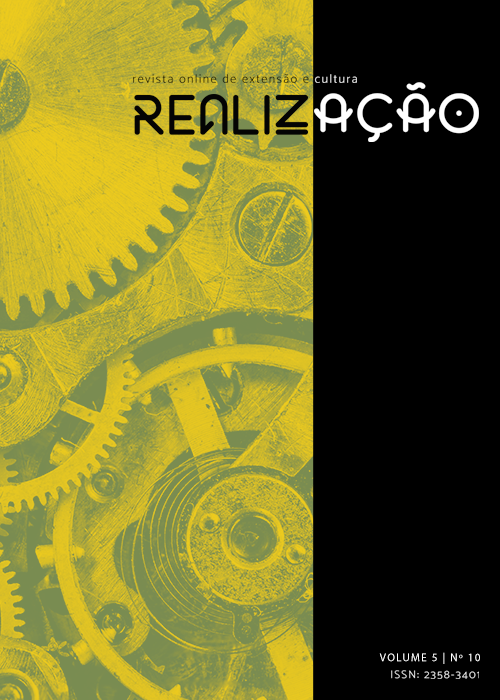Planning of environmental education activities in a unit of conservation
DOI:
https://doi.org/10.30612/re-ufgd.v5i10.8594Keywords:
PEVRI. SWOT Matrix. Socio-environmental integration.Abstract
The present study aimed to apply the SWOT method as a tool to analyze the use of environmental education in the Ivinhema River Basin State Park (PEVRI), located in the municipality of Jateí/MS. This study is also part of the teaching and extension activities aimed at the restructuring of the PEVRI Management Plan. A qualitative, exploratory-descriptive research was conducted with the purpose of pointing out the strengths, weaknesses, threats and opportunities. The information was obtained after in situ observation through technical trip and later bibliographical survey. The collected data were collected in the SWOT matrix. The matrix was scored taking into account the degree of importance of the situations that exist in the park. Based on the results, a table was created with the internal aspects and external aspects of the PEVRI. The SWOT was analyzed by Luz Planilhas Empresariais Program 3.0. The result of the comparison of strengths, weaknesses, opportunities and threats shows that although the park has a degraded structure, it has potential for recreation, leisure and environmental education. However, little attention has been paid by public authorities to socio-environmental integration and maintenance of the park. Through cross-data analysis in the SWOT matrix, it can be seen that the strategies involve action plans for population awareness, involvement of public agencies, partnerships with the academic community, among others. Thus, despite the negative points, the PEVRI has positive aspects that can leverage the development of Environmental Education activities.
Downloads
References
ABREU, B. S.; ABREU, I. G.; MORAIS, P. S. A.; FERREIRA, C. M. A. Educação ambiental e a gestão participativa dos recursos naturais: interrelação necessária para surgimento de um novo paradigma. Polêmica, v 11, n. 3, 2012.
BRASIL. MINISTÉRIO DO MEIO AMBIENTE. SNUC – Sistema Nacional de Unidades de Conservação da Natureza: Lei nº 9.985, de 18 de julho de 2000. Brasília: MMA.
LOUREIRO, C. F. B. CUNHA, C. C. Educação ambiental e gestão participativa de unidades de conservação: elementos para se pensar a sustentabilidade democrática. Ambiente e Saúde, v. 11, n. 2, p. 237-253, 2008.
MEDEIROS, A. B.; MENDONÇA, M. J. S. L.; SOUSA,G. L.; OLIVEIRA, I. P. A Importância da educação ambiental na escola nas séries iniciais. Revista Faculdade Montes Belos, v. 4, n. 1, p. 1-17, 2011.
OCON, D. C. M. Grupos de poder e território: criação e implantação do Parque Estadual das Várzeas do Rio Ivinhema – PEVRI – MS. 301 f. Tese (Doutorado em Geografia) – Universidade Estadual do Maringá. 2015.
PEREIRA, Z. V. KINOSHITA, L. S. Rubiaceae Juss. do Parque Estadual das Várzeas do Rio Ivinhema, MS, Brasil. Revista Hoehnea, v. 40, n. 2, São Paulo Jun- 2013.
UNESCO. Década da Educação das Nações Unidas para um Desenvolvimento Sustentável, 2005-2014: documento final do esquema internacional de implementação, Brasília, Brasil, 2005. 120 p.
Downloads
Published
How to Cite
Issue
Section
License
Autores que publicam nesta revista aceitam as normas de publicação, bem como, concordam com os seguintes termos:
(a) O Conselho Editorial se reserva ao direito de efetuar, nos originais, alterações da Língua portuguesa para se manter o padrão culto da língua, respeitando, porém, o estilo dos autores.
(b) Autores mantém os direitos autorais e concedem à revista o direito de primeira publicação, com o trabalho simultaneamente licenciado sob a Atribuição-NãoComercial-CompartilhaIgual 3.0 Brasil (CC BY-NC-SA 3.0 BR) que permite: Compartilhar — copiar e redistribuir o material em qualquer suporte ou formato e Adaptar — remixar, transformar, e criar a partir do material. A CC BY-NC-SA 3.0 BR considera os termos seguintes:
- Atribuição — Você deve dar o crédito apropriado, prover um link para a licença e indicar se mudanças foram feitas. Você deve fazê-lo em qualquer circunstância razoável, mas de nenhuma maneira que sugira que o licenciante apoia você ou o seu uso.
- NãoComercial — Você não pode usar o material para fins comerciais.
- CompartilhaIgual — Se você remixar, transformar, ou criar a partir do material, tem de distribuir as suas contribuições sob a mesma licença que o original.
- Sem restrições adicionais — Você não pode aplicar termos jurídicos ou medidas de caráter tecnológico que restrinjam legalmente outros de fazerem algo que a licença permita.

